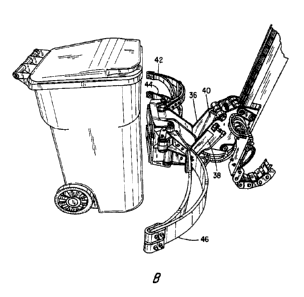Une partie des informations de ce site Web a été fournie par des sources externes. Le gouvernement du Canada n'assume aucune responsabilité concernant la précision, l'actualité ou la fiabilité des informations fournies par les sources externes. Les utilisateurs qui désirent employer cette information devraient consulter directement la source des informations. Le contenu fourni par les sources externes n'est pas assujetti aux exigences sur les langues officielles, la protection des renseignements personnels et l'accessibilité.
L'apparition de différences dans le texte et l'image des Revendications et de l'Abrégé dépend du moment auquel le document est publié. Les textes des Revendications et de l'Abrégé sont affichés :
| (12) Brevet: | (11) CA 2970306 |
|---|---|
| (54) Titre français: | SYSTEME DE TRAITEMENT DE CONTENEUR AUTOMATISE DESTINE AUX VEHICULES DE COLLECTE DE DECHETS |
| (54) Titre anglais: | AUTOMATED CONTAINER HANDLING SYSTEM FOR REFUSE COLLECTION VEHICLES |
| Statut: | Octroyé |
| (51) Classification internationale des brevets (CIB): |
|
|---|---|
| (72) Inventeurs : |
|
| (73) Titulaires : |
|
| (71) Demandeurs : |
|
| (74) Agent: | MLT AIKINS LLP |
| (74) Co-agent: | |
| (45) Délivré: | 2018-11-13 |
| (22) Date de dépôt: | 2017-06-12 |
| (41) Mise à la disponibilité du public: | 2017-08-15 |
| Requête d'examen: | 2017-06-12 |
| Licence disponible: | S.O. |
| (25) Langue des documents déposés: | Anglais |
| Traité de coopération en matière de brevets (PCT): | Non |
|---|
| (30) Données de priorité de la demande: | ||||||
|---|---|---|---|---|---|---|
|
Le système de traitement de conteneur automatisé destiné aux véhicules de collecte de déchets est présenté qui emploie une caméra vidéo installée sur véhicule qui alimente un moniteur installé sur la cabine pour informer un conducteur de lemplacement dun conteneur dintérêt permettant un alignement précis du véhicule. Le système est actionné par un seul bouton dans la cabine et comprend un bras extensible, pivotant, doté dune base équipée dun appareil de préhension convergent servant à saisir et vider le conteneur. La base qui saisit le conteneur comprend un transducteur à sonar qui fonctionne à laide dun système hydraulique qui actionne le bras de lappareil de préhension au moyen dun programme informatique de contrôleur logique programmable pour actionner les commandes hydrauliques.
A fully automated container handling system for a refuse vehicle is provided that utilizes a vehicle-mounted video camera which feeds video to a cab-mounted monitor to inform a driver of the location of a container of interest enabling accurate alignment of the vehicle. The system is operated by a single button in the cab and includes an extending, pivoting arm with a base equipped with a converging grabber to seize and empty the container. The base that grabs the container includes a sonar transducer that functions with a hydraulic system that operates the arm and grabber using a programmable logic controller (PLC) computer program to run the hydraulic controls.
Note : Les revendications sont présentées dans la langue officielle dans laquelle elles ont été soumises.
Note : Les descriptions sont présentées dans la langue officielle dans laquelle elles ont été soumises.

Pour une meilleure compréhension de l'état de la demande ou brevet qui figure sur cette page, la rubrique Mise en garde , et les descriptions de Brevet , États administratifs , Taxes périodiques et Historique des paiements devraient être consultées.
| Titre | Date |
|---|---|
| Date de délivrance prévu | 2018-11-13 |
| (22) Dépôt | 2017-06-12 |
| Requête d'examen | 2017-06-12 |
| (41) Mise à la disponibilité du public | 2017-08-15 |
| (45) Délivré | 2018-11-13 |
Il n'y a pas d'historique d'abandonnement
Dernier paiement au montant de 277,00 $ a été reçu le 2024-04-23
Montants des taxes pour le maintien en état à venir
| Description | Date | Montant |
|---|---|---|
| Prochain paiement si taxe générale | 2025-06-12 | 277,00 $ |
| Prochain paiement si taxe applicable aux petites entités | 2025-06-12 | 100,00 $ |
Avis : Si le paiement en totalité n'a pas été reçu au plus tard à la date indiquée, une taxe supplémentaire peut être imposée, soit une des taxes suivantes :
Les taxes sur les brevets sont ajustées au 1er janvier de chaque année. Les montants ci-dessus sont les montants actuels s'ils sont reçus au plus tard le 31 décembre de l'année en cours.
Veuillez vous référer à la page web des
taxes sur les brevets
de l'OPIC pour voir tous les montants actuels des taxes.
| Type de taxes | Anniversaire | Échéance | Montant payé | Date payée |
|---|---|---|---|---|
| Examen avancé | 500,00 $ | 2017-06-12 | ||
| Requête d'examen | 800,00 $ | 2017-06-12 | ||
| Enregistrement de documents | 100,00 $ | 2017-06-12 | ||
| Le dépôt d'une demande de brevet | 400,00 $ | 2017-06-12 | ||
| Taxe finale | 300,00 $ | 2018-09-28 | ||
| Taxe de maintien en état - brevet - nouvelle loi | 2 | 2019-06-12 | 300,00 $ | 2019-07-12 |
| Taxe de maintien en état - brevet - nouvelle loi | 3 | 2020-06-12 | 100,00 $ | 2020-06-05 |
| Taxe de maintien en état - brevet - nouvelle loi | 4 | 2021-06-14 | 100,00 $ | 2021-05-19 |
| Taxe de maintien en état - brevet - nouvelle loi | 5 | 2022-06-13 | 203,59 $ | 2022-04-20 |
| Taxe de maintien en état - brevet - nouvelle loi | 6 | 2023-06-12 | 210,51 $ | 2023-05-17 |
| Taxe de maintien en état - brevet - nouvelle loi | 7 | 2024-06-12 | 277,00 $ | 2024-04-23 |
Les titulaires actuels et antérieures au dossier sont affichés en ordre alphabétique.
| Titulaires actuels au dossier |
|---|
| CON-TECH MANUFACTURING, INC. |
| Titulaires antérieures au dossier |
|---|
| S.O. |